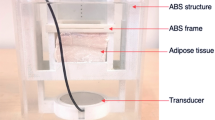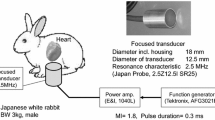Abstract
Purpose
In high-intensity focused ultrasound (HIFU) comprising high-intensity burst ultrasound (triggering pulse) and medium-intensity continuous wave ultrasound (heating wave), optimizing the effects of the triggering pulse conditions on the coagulated volume may help to reduce treatment times.
Methods
HIFU combined with a triggering pulse was applied to chicken deep pectoral muscles. The acoustic power of the heating wave was set to 36, 54, or 72 W. Four different triggering pulse conditions were used: heating wave only; or pulse widths and pulse repetition frequencies of 30 μs and 1 kHz, 300 μs, and 100 Hz, or 3 ms and 10 Hz.
Results
Compared to the heating wave only condition, the coagulated volume was significantly larger under all conditions that included a triggering pulse. Significant differences were also observed in the ellipticity of the coagulated region between some conditions.
Conclusion
HIFU combined with a triggering pulse may play an important role in reducing treatment times.






Similar content being viewed by others
References
Kennedy JE. High-intensity focused ultrasound in the treatment of solid tumors. Nat Rev Cancer. 2005;5:321–7.
ter Haar GR. High intensity focused ultrasound for the treatment of tumors. Echocardiography. 2001;18:317–22.
Fan TY, Zhang L, Chen W, et al. Feasibility of MRI-guided high intensity focused ultrasound treatment for adenomyosis. Eur J Radiol. 2012;81:3624–30.
Frenkel V, Kimmel E, Iger Y. Ultrasound-induced cavitation damage to external epithelia of fish skin. Ultrasound Med Biol. 1999;25:1295–303.
Rosenthal I, Sostaric JZ, Riesz P. Sonodynamic therapy—a review of the synergistic effects of drugs and ultrasound. Ultrason Sonochem. 2004;11:349–63.
Kim YS, Rhim H, Choi MJ, et al. High-intensity focused ultrasound therapy: an overview for radiologists. Korean J Radiol. 2008;9:291–302.
Frenkel V, Li KC. Potential role of pulsed-high intensity focused ultrasound in gene therapy. Future Oncol. 2006;2:111–9.
Takagi R, Yoshizawa S, Umemura S. Enhancement of localized heating by ultrasonically induced cavitation in high intensity focused ultrasound treatment. Jpn J Appl Phys. 2010;49:07HF21.
Inaba Y, Yoshizawa S, Umemura S. Coagulation of Large Regions by Creating Multiple Cavitation Clouds for High Intensity Focused Ultrasound Treatment. Jpn J Appl Phys. 2010;49:07HF22.
Shaw A. A buoyancy method for the measurement of total ultrasound power generated by HIFU transducers. Ultrasound Med Biol. 2008;34:1327–42.
Feril LB Jr, Kondo T, Cui ZG, et al. Apoptosis induced by the sonomechanical effects of low intensity pulsed ultrasound in a human leukemia cell line. Cancer Lett. 2005;221:145–52.
Hundt W, Yuh EL, Steinbach S, et al. Comparison of continuous vs. pulsed focused ultrasound in treated muscle tissue as evaluated by magnetic resonance imaging, histological analysis, and microarray analysis. Eur Radiol. 2008;18:993–1004.
Hundt W, Yuh EL, Steinbach S, et al. Mechanic effect of pulsed focused ultrasound in tumor and muscle tissue evaluated by MRI, histology, and microarray analysis. Eur J Radiol. 2010;76:279–87.
Acknowledgments
We would like to thank Shin Yoshizawa and Shin-ichiro Umemura for assistance with the use of the HIFU transducer. This research was partially supported by the Ministry of Economy, Trade and Industry, Japan (METI, Standardization Promotion Project). A part of this research was supported by a grant from the Japan Society for the Promotion of Science (JSPS) through the “Funding Program for World-Leading Innovative R&D on Science and Technology (FIRST Program),” initiated by the Council for Science and Technology Policy (CSTP).
Conflict of interest
None.
Author information
Authors and Affiliations
Corresponding author
About this article
Cite this article
Abe, N., Nakamoto, H., Suzuki, T. et al. Ex vivo evaluation of high-intensity focused ultrasound with ultrasonic-induced cavitation bubbles. J Med Ultrasonics 41, 3–9 (2014). https://doi.org/10.1007/s10396-013-0469-9
Received:
Accepted:
Published:
Issue Date:
DOI: https://doi.org/10.1007/s10396-013-0469-9




